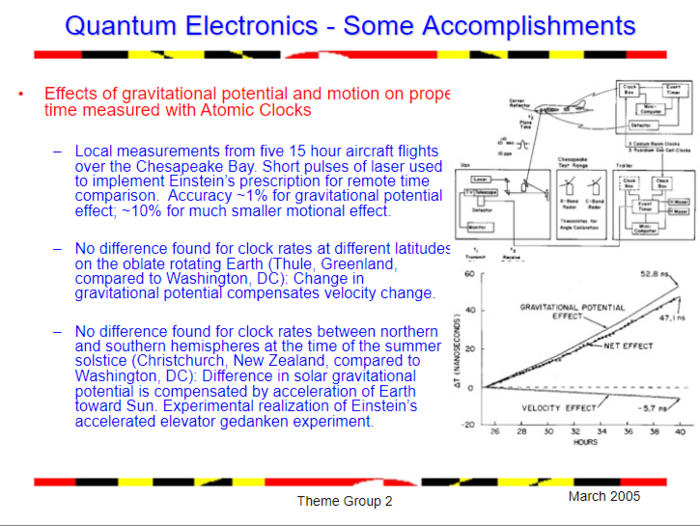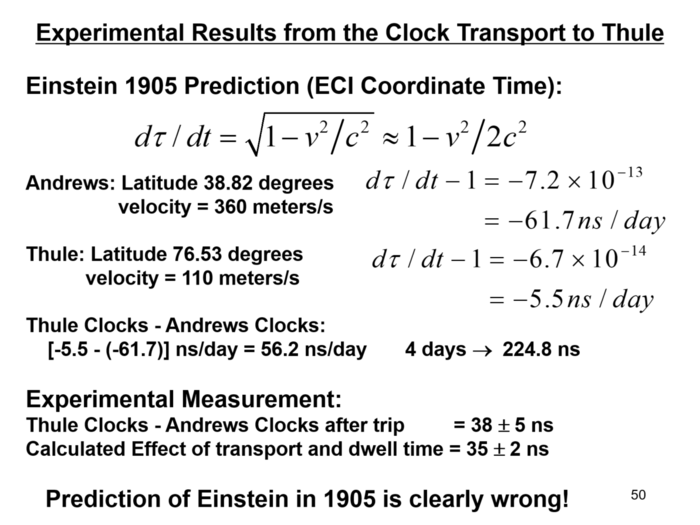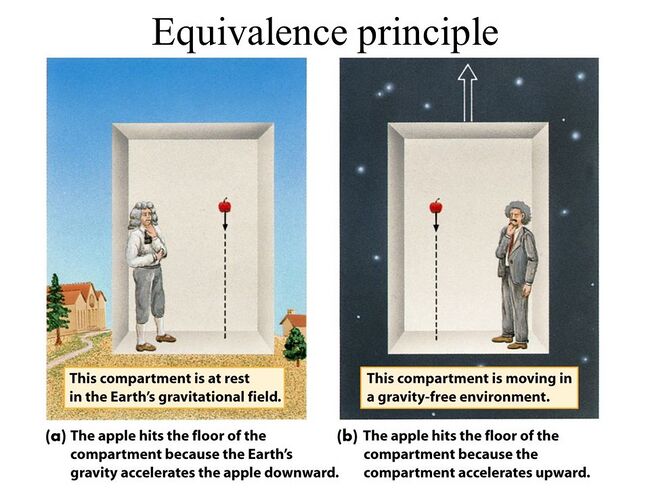Time Dilation by Latitude
Time Dilation by Latitude refers to Albert Einstein's prediction that clocks would tick slower at the equator than at the poles.
From The Fascinating Life and Theory of Albert Einstein (Archive):
“ In Einstein's original paper on the Special Theory of Relativity, "On the Electrodynamics of Moving Bodies", he mentioned a thought experiment using two identical clocks. One clock was placed on the equator and the other at one pole of the Earth. The clock on the equator had a faster speed then that at the pole due to the rotation of the Earth. He claimed that the clock on the equator would run slower than the one at the pole. ”
Predicted by several authors at the turn of the 20th century, and later verified with various experiments, the phenomenon of time dilation due to velocity is a known phenomena. Experiment such as the Hafele and Keating Experiment showed that time dilates in on-board atomic clocks when two jets recede quickly away from each other. NIST was able to show (Archive) that time dilation by velocity can be shown to occur at speeds comparable to 20 miles per hour:
“ The NIST researchers also observed another aspect of relativity—that time passes more slowly when you move faster—at speeds comparable to a car travelling about 20 miles per hour, a more comprehensible scale than previous measurements made using jet aircraft. ”
It is reasoned that, since the Earth is rotating, time must also dilate according to the different latitudinal speeds of a rotating Earth. Precision clocks were not yet advanced enough to measure the effect at the time of Einstein's prediction, but with the advancement of atomic clocks over the years there have been efforts to use these technologies to measure and demonstrate this effect.
University of Maryland
https://umdgrb.umd.edu/~goodman/review/ThemeGroup2_Exp.ppt (Archive)
In 2005 the University of Maryland found that there was no difference in clock time with Atomic Clocks:
Clock Transport to Thule
A University of Maryland at College Park slideshow shows the following (Archive):
University of Adelaide
The equivalence principle as a stepping stone from special to general relativity: A Socratic dialog
S. P. Drake
School of Chemistry and Physics
Professor Drake at the University of Adelaide explains that there is no time dilation between different latitudes. Professor Drake then proceeds to provide an explanation for the lack of time dilation. The paper is written in the form of Socratic dialog.
“ Kim: Your lectures on special relativity fascinated me, and when I got home I wondered if I could construct a simple experiment to prove or disprove time dilation, the aspect of special relativity that interests me the most. While lying in bed before dozing off, I realized that a clock placed at the equator should run slower than a clock placed at the pole. So I did a little calculation and found that special relativity predicts that a clock on the equator runs slower by about 100 ns per day with respect to a clock at the pole. Although this effect is not large, it is certainly measurable with modern atomic clocks. So I went onto the internet to see if I could find any reference to such an experiment and to my surprise I couldn’t.
I was starting to get so frustrated that I couldn’t sleep. I glanced at the clock - 3 am. I thought to myself “How accurate is my clock?” I should check it against internet time. Then it occurred to me that the world timing standard organizations must mention a latitude effect on local clock accuracies. So I went onto the internet again and checked The Bureau International des Poids et Mesures2 because the Bureau calculates the international atomic time from atomic clocks located in more than 30 countries around the world. I was sure that I must find something about the latitude effect on their web site. After spending hours trawling their site and then other sites on the web, I came up with nothing. There was a discussion of the relativistic effect of placing clocks at high altitudes, but nothing about latitude. In my despair I gave up and collapsed into a fitful sleep.
I came to see you today in the hope that you could cure my insomnia.
Sam: You are in good company in thinking that clocks at the equator and the pole should tick at different rates. Einstein himself predicted as much in his famous 1905 paper on the special theory of relativity.3 Luckily for physics the effect was not measurable with the instruments of the day because Einstein’s prediction would have failed to match experiment.
Let us return to your findings:
- According to the special theory of relativity a clock located at the equator should run slower than one at the pole and
- Empirically, all clocks located at sea-level on the Earth’s surface tick at the same rate, regardless of latitude. ”
Explanation
In order to explain the lack of this effect on a rotating Earth, Professor Drake goes on to explain that clocks tick the same rate by virtue of Einstein's Equivalence Principle:
“ Sam: Suppose you are floating in a room with no windows or doors. All of a sudden, you feel a force that throws you against the wall. If there were two possible forces, gravitational and centrifugal, are you able to determine which force you are feeling?
...The idea that you can’t know if the force is a uniform gravitational force or a combination of uniform forces, is called the equivalence principle. What does it tell you about clocks on the surface of the Earth? ”
Luboš Motl
Theoretical physicist Luboš Motl (bio) also uses the Equivalence Principle to cancel out the effect. From his blog:
https://motls.blogspot.com/2014/07/is-time-going-slowly-near-equator.html?m=1 (Archive)
“ John Rennie – who is going to jump above me at Physics Stack Exchange in a few months unless I will find motivation to prevent him from doing so – has asked a very nice question:
"The Earth is spinning so all people living at the equator are apparently moving at 464 m/s relatively to what seems like a 'better inertial frame'. By the special relativistic time dilation, this should slow their time by one part per trillion. That would be a 100 larger relative effect than the accuracy you may achieve with state-of-the-art atomic clocks. Has someone measured this effect that should be measurable?"
The answer is actually funny (especially if you say more than just the word "No"). Let me just repost mine.
The difference would indeed be measurable with state-of-the-art atomic clocks but it's not there: it cancels. The reasons actually boil down to the very first thought experiments that Einstein went through when he realized the importance of the equivalence principle for general relativity
~
Every argument showing the exact cancellation of the special relativistic effect must use the equivalence principle at one point or another; any argument avoiding this principle – or anything else from general relativity – is guaranteed to be incorrect because separately (without gravity and its effects), the special relativistic effect is certainly there. ”
Discover Magazine
On this topic Discover Magazine explains the identical clock rates as a result of Einstein's Equivalence Principle:
Discover Magazine - Einstein’s ‘Imaginary Elevator’ Thought Experiment Proven Right Again
“ Well, Einstein’s done it again!
That is to say, the gravitational theories of Albert Einstein have once again been confirmed, and to a new degree of precision. The equations of general relativity predicted a certain quantity would be zero, and physicists at the National Institute of Standards and Technology (NIST) have calculated a record-low, unbelievably tiny result — basically, as good to zero as we can get.
So what did they measure? The variation between different ultra-precise atomic clocks around the world as it orbited the sun. It’s … a bigger deal than it sounds like.
Elevator Action
Part of Einstein’s genius was his ability to think things through using just his imagination. These so-called gedankenexperiments (“thought experiments”) yielded many of his insights in formulating the theory of general relativity, which focuses on gravity’s effects.
Among the more famous examples is one focusing on an imaginary elevator. Someone inside would be unable to distinguish a gravitational field from acceleration — the downward pressure you normally feel from Earth pulling at you could just as easily be the elevator accelerating ‘upward’ toward you in zero gravity. Stuck inside the elevator, with no windows, you couldn’t tell the difference.
The NIST team tested another aspect of the thought experiment, which says that everything inside the elevator would feel the same accelerations, and their relative properties would remain constant — zero change. It’s an idea called local position invariance (LPI). They used Earth itself as the elevator, and compared the “ticks” of a dozen atomic clocks all over the planet. After studying nearly 15 years’ worth of data the results were in: the difference was just 0.00000022 plus or minus 0.00000025. Pretty close to zero! ”
Addendum
The above authors use Einstein's Equivalence Principle to explain why clocks at sea level all tick at the same rate across the surface of the Earth and champion it as a success of Einstein, despite Albert Einstein making the opposite prediction on the matter. Possessing more knowledge about Einstein's theories than Einstein himself, the writers salvage the matter by telling us that the expected time dilation is erased by the Equivalence Principle. The Equivalence Principle is a principle of nature which says that effects on Earth are indistinguishable from an environment which is accelerating upwards.
From a University of Iowa presentation (Archive):
This approach of using an upwardly accelerating Earth as an explanation for why clocks at sea level all tick at the same rate is one which we can only express agreement with. Curiously, this principle not only applies to gravity, but to the rotational motion of the Earth as well. It has been argued that the Equivalence Principle is only a local effect, yet we find university explanations which utilize it as a worldwide effect to explain why time dilation does not occur at different latitudes due to the different latitudinal speeds of the Earth. Dr. Motl even goes as far as to say that it is only possible to cancel out the effect by using the Equivalence Principle and that any other argument is assuredly incorrect.
Time dilates at different altitudes in agreement with an upwardly accelerating Earth1, but not at different latitudes as suggested by a rotating Round Earth. It once again dawns upon the thinking man that our Earth is not the globe of popular credulity, but an upwardly accelerating plane.
Footnotes
- 1 The Equivalence Principle predicts that time dilates at different altitudes. See:
- Evidence for Universal Acceleration: Gravitational Time Dilation
- The dedicated page for Gravitational Time Dilation
See Also
Flat Earth Topics on Rotation and Revolution
- Michelson-Morley Experiment - Light velocity experiment which suggests a lack of Earth's motion around the Sun
- Sagnac Experiment - Experiments which show that light's velocity is indeed affected by detector motion
- Airy's Failure - An experiment which suggests that the stars are in motion, rather than the Earth
- Time Dilation by Latitude - The predicted time dilation caused by Earth's rotation does not occur
- Aviation - Mechanical air flight assumes a flat, non-rotating Earth
Round Earth Topics on Rotation
- Foucault Pendulum - Pendulum device which is alleged to detect the rotation of Earth
- Coriolis Effect - Eastwards deflection of bodies caused by Earth's rotation
- Coriolis Effect (Weather) - Hurricanes and other effects due to Earth's rotation
- Ring Laser Gyroscope - Ring laser experiment alleged to observe the rotation of Earth



